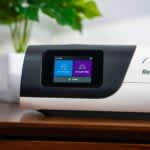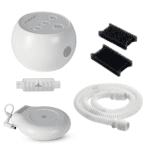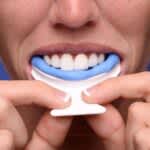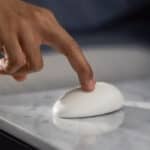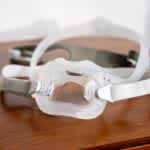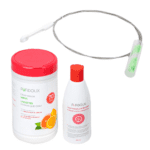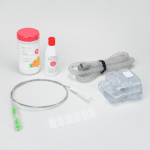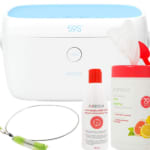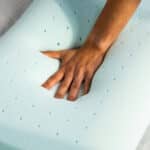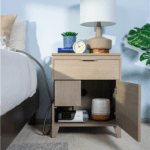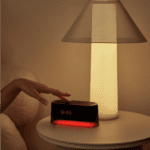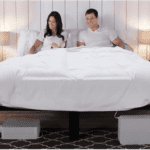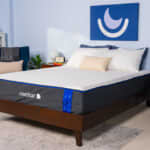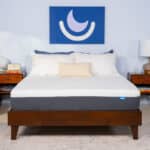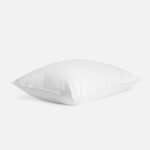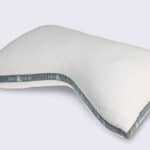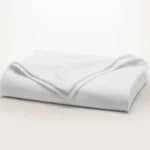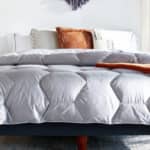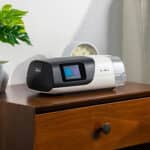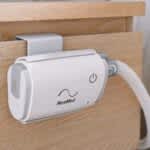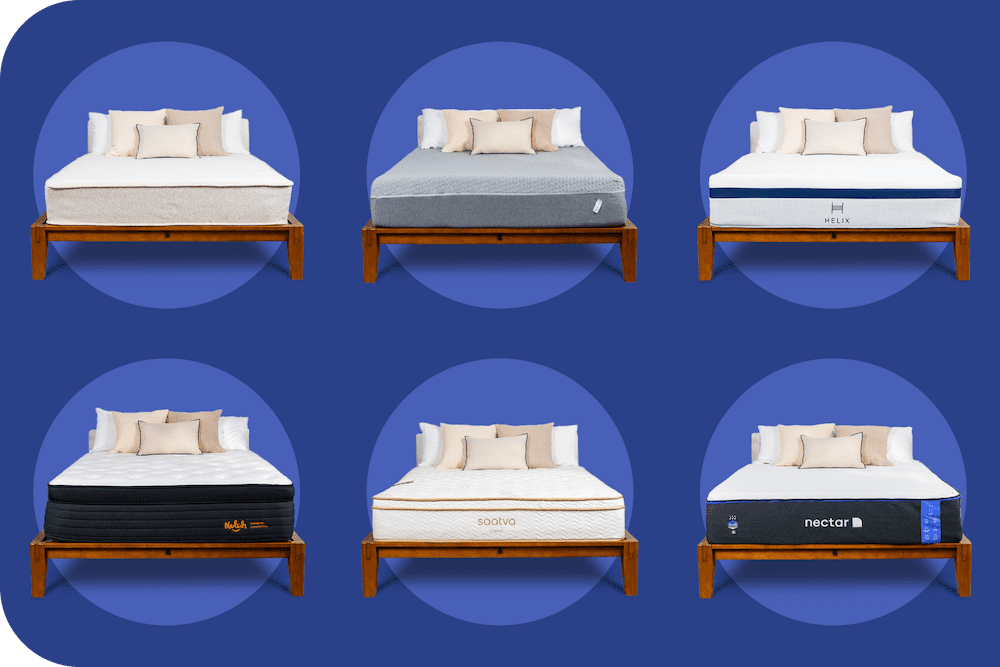Just as smartphones combine an ordinary phone with the latest technology, smart beds do the same thing with the humble mattress. Technological advances have allowed manufacturers to offer beds that can track your sleep, adjust temperature and firmness levels, and more.
Best Smart Mattresses
-
Best Overall Mattress
–
Solaire
View Details
-
Best Temperature Control
–
Tempur-Pedic TEMPUR-ActiveBreeze Smart Bed
View Details
Swipe for more
Best Overall Mattress
Solaire
$300 off orders of $1,000 or more
$300 off orders of $1,000 or more
The Solaire from Saatva is an airbed that allows you to adjust the mattress’ firmness level between soft and extra firm feels. The adjustability and dual-sided design make the mattress a great choice for most sleepers and couples with different preferences.

Ideal For
Combination Sleepers
Firmness Range
Soft (3) to Firm (8)
Feel
Supportive Surface
Value
Good Value
Pros & Cons

-
Pros
-
50 firmness settings range from soft (3) to firm (8) make it easy to find an option that works for you
-
Pairs well with an adjustable bed base
-
365-night sleep trial and lifetime warranty
-
-
Cons
-
May not offer enough pressure relief for all back and stomach sleepers below 130 pounds
-
Does not offer data tracking or temperature control
-
Changing the firmness level produces a light noise
-
Our Take

The Saatva Solaire is an adjustable airbed with 50 firmness options ranging from soft (3) to firm (8). Sleepers have the option to adjust the firmness using a remote control and save their favorite firmness level. Our testers liked that queen and larger mattress sizes featured a separate air chamber on each side of the bed, which allowed each partner to select their preferred firmness according to their individual needs.
Why We Like It
Because of its adjustable design, the Solaire performed well for our testers across the board, particularly for those over 130 pounds. The breathable materials help keep heat retention to a minimum, and the latex layer adds a responsive feel that makes it easier to switch positions.
Saatva offers the Solaire in twin XL, full, queen, king, split king, California king, and split California king sizes. You can also opt for an upper flex option with king and queen models that can be paired with Saatva’s Lineal Base for additional comfort options.
We found that the adjustable firmness, zoned comfort system, and reinforced edge support made the Saatva Solaire a good option for combination sleepers as well as those over 130 pounds.
How Does It Feel?
Above the air chambers, a quilted organic cotton Euro-top cover sits atop a 1-inch layer of aerated Talalay latex. We found this gave the mattress a light, responsive feel. The natural latex is also certified by the Rainforest Alliance and zoned into five sections, which offered our testers targeted support and pressure relief.
An additional 2-inch layer of gel-infused memory foam adds contouring, and a moisture barrier protects the vulcanized rubber air chambers. The foam perimeter encasement helps reinforce the edges, making it easier for you to get in and out of bed.
Sleeper Type Ratings

The ratings below indicate how suitable this mattress is for different sleeping positions and sleeper weights, taking into account factors such as support and pressure relief.
Best Temperature Control
Tempur-Pedic TEMPUR-ActiveBreeze Smart Bed
$9,988 from Tempur-Pedic (queen)
$9,988 from Tempur-Pedic (queen)
If you’re looking for a smart bed with state-of-the-art temperature control, the TEMPUR-ActiveBreeze offers active heating and cooling with separate settings on each side. The all-foam mattress excels at motion isolation and pressure relief, while the Smart PowerBase comes with features to reduce lower back pain and prevent snoring.
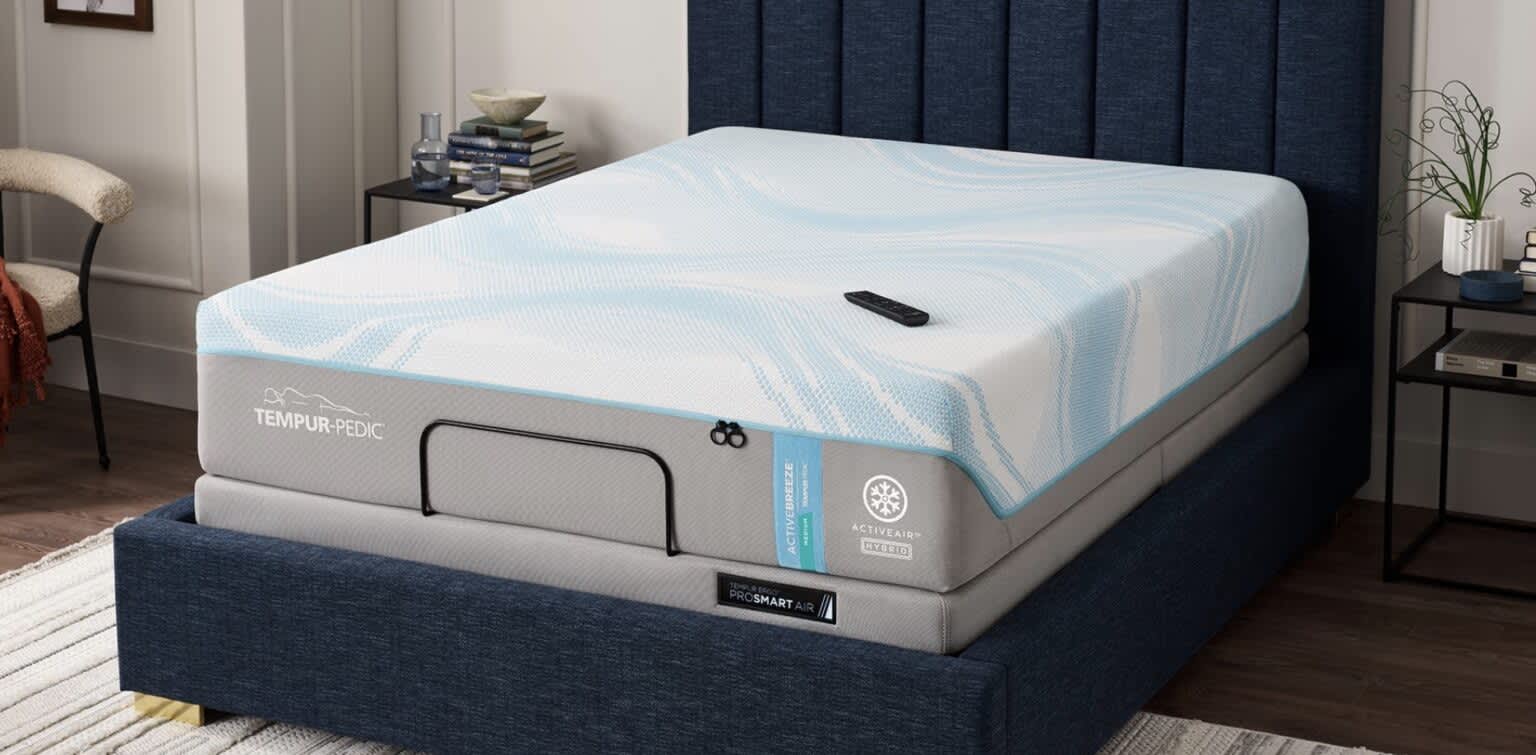
Ideal For
Hot Sleepers
Firmness
Medium (5)
Feel
Close-Conforming Foam
Value
Fair Value
Pros & Cons

-
Pros
-
Dual climate control lets you and your partner customize the temperature on your side of the bed
-
Ventilated foam layers cushion the body without trapping heat
-
Base automatically elevates the head if snoring is detected
-
-
Cons
-
Potentially too soft for people over 230 pounds
-
Hefty price-tag even by smart bed standards
-
Our Take

Why We Like It
The Tempur-Pedic TEMPUR-ActiveBreeze is one of the most sophisticated smart beds on the market. Your purchase includes a mattress and adjustable base, so the sticker price is fairly steep, but the long-term value is high if you tend to sleep hot or cold. You can adjust your side of the bed to 30 degrees warmer or cooler than room temperature, and your partner can customize their side with different settings.
The Power SmartBase is advanced in its own right. One standout feature is the automatic snore response — if the built-in sensors detect snoring, your side of the bed automatically elevates to raise your head and expand your airway. A horizontal bar beneath your lumbar region can be raised up to 6 inches to alleviate aches and pains in your lower back and hips. The Sleeptracker-AI smartphone app can be used to make adjustments and access sleep coaching programs.
How Does It Feel?
The TEMPUR-ActiveBreeze is constructed with three foam comfort layers, all of which are ventilated to circulate air throughout the interior. These materials make the surface feel exceptionally plush and adaptive, so you’ll notice a deep cradling effect as your body settles into the mattress. A medium (5) feel makes the TEMPUR-ActiveBreeze best suited to side and back sleepers up to 230 pounds. Those who weigh more should consider a firmer mattress — especially if they sleep on their stomach.
The support core features the Hybrid Technology Air Distribution Layer, a hollow channel that helps facilitate the active cooling and heating in the bed’s SmartClimate cover. Six sizes are available, including a split king allowing you and your partner to sleep at different angles. Setting up the mattress and adjustable base may sound like a daunting task, but Tempur-Pedic includes free White Glove delivery and setup with all orders in the contiguous U.S.
Sleeper Type Ratings

The ratings below indicate how suitable this mattress is for different sleeping positions and sleeper weights, taking into account factors such as support and pressure relief.
However, shopping for a smart bed can be confusing. We’ll make the process easier by covering some of the best models, then walk you through the wide range of features and factors to consider when buying one.
If you decide against a smart bed, check out our guide to the best mattresses of 2025. We also have guides for more specific needs, such as our list of the best mattresses for back pain.
Best Overall Mattress
Solaire
$300 off orders of $1,000 or more
SHOP NOWAn adjustable firmness system gives you full control over your bed’s feel at the touch of a button.
SEE MORE DETAILS

Best Temperature Control
Tempur-Pedic TEMPUR-ActiveBreeze Smart Bed
$9,988 from Tempur-Pedic (queen)
SHOP NOWAn advanced mattress and adjustable base combo with cutting-edge heating and cooling.
SEE MORE DETAILS

What Makes a Mattress “Smart?”
Smart mattresses use advanced technology in their cover, comfort system, or support core. Some are designed to be more comfortable than standard beds, such as those with adjustable firmness or temperature settings, while others offer features like sleep tracking or vibration-based alarms that will wake you but not your partner.
Many smart beds can be adjusted using a smartphone app or remote, allowing for push-button functionality and programmable settings. However, just like other smart devices, one downside of smart mattresses is that advanced features can sometimes be locked behind a subscription-based service.
The major downsides of smart mattresses are price and sensitivity. All those technological components and features come at an extra cost, and depending on the model, some parts can be a bit finicky or less durable. That being said, warranties for smart mattresses tend to be relatively robust, and repairs or replacements aren’t too difficult to arrange.
Common Features of a Smart Mattress
Although smart mattresses share an important thing in common — they all use technology to improve your sleep — the features each offers can vary dramatically. These are not all the features available, but they are among the most popular.
| Feature | Description |
|---|---|
| Adjustable Firmness | Smart mattresses with adjustable firmness settings use air-filled chambers that inflate or deflate to change how the bed feels and meet different firmness needs. Larger beds often have separate chambers for each side of the bed, and some luxury models are zoned for different firmness levels under different areas of the body. |
| Sleep Tracking | Some smart beds gather information about your sleep, including how long you spend in each sleep stage and how much you toss and turn, so you can easily learn about and monitor your sleep health. However, this data is not as accurate as that obtained through a formal sleep study or actigraphy. |
| Biometric Monitoring | Biometric monitoring uses sensors to track physical parameters like your heart rate and breathing. Many smart beds use this data to aid in sleep tracking, but some people may also appreciate having the biometric data as part of tracking their overall health. |
| Temperature Control | Smart beds with temperature control allow sleepers to set their preferred temperature and may even allow for timed temperature changes or automatic temperature adjustment. Most smart beds with this feature use water or air-based heating and cooling technology. |
| Alarms and Audio | Smart mattress alarms usually have silent options that use vibration or temperature changes to wake you up without disturbing your partner. Some smart beds also offer audio features such as white noise, nature sounds, or guided meditation. |
| Connectivity | Many smart beds pair with an app that allows users to access features like data tracking or firmness and temperature controls. Integration with voice assistants like Siri and Alexa is also possible with some smart mattresses. |
Video: Should You Use a Sleep Tracker?
Sleep trackers can offer some really helpful insights into your overall sleep health, especially if you have a smart mattress. But learning how to use one can be overwhelming. Our sleep expert breaks down the key data points you should be paying the most attention to.
Is a Smart Mattress Right for You?
Choosing a smart mattress can feel difficult, since there are far fewer options compared to standard mattresses, and the variety of features makes comparing models more complicated. The higher price of smart beds can also make the process more stressful. However, considering your needs, preferences, budget, and sleeping situations can help you determine if a smart mattress is your best option.
| Who Might Want to Consider a Smart Mattress? | Who Might Not Enjoy a Smart Mattress? |
|---|---|
|
|
What to Consider in a Smart Mattress
When choosing a smart mattress, it’s easy to lose sight of ordinary considerations and focus entirely on the technological aspects. However, even the most cutting-edge smart bed will lead to poor sleep if you don’t choose a mattress that suits your needs.
Materials
Although there are many types of mattresses available, most smart beds are all-foam or airbeds. All-foam mattresses use high-density polyfoam in the support core, while airbeds feature air-filled chambers that allow sleepers to adjust the firmness level.
A mattress’s comfort layers also play a major role in how a bed feels. Synthetic foam, including memory foam, is a popular choice for the way it contours around your body to reduce pressure and tension. Natural latex foam is also common in smart beds, as it sleeps cool and offers a more responsive bounce without sacrificing pressure relief.
Usability
Many smart beds can now be adjusted using an app, although there are still some that use a remote control. Mattresses with data tracking usually require users to access their information via an app.
If you already have a smart home set up, such as using a voice-controlled assistant like Alexa or Siri, you’ll want to double-check that your chosen bed is compatible with it.
Pricing
Smart beds vary in price, from $1,000 to over $10,000, but the vast majority are significantly more expensive than a comparable standard mattress. The cost of a smart mattress depends on factors such as features, mattress design, and more, making it difficult to compare prices the way one would with a standard bed.
Some smart mattresses also require users to purchase a subscription for a set period, permanently, or if they want to access advanced features.
Accessories
When you buy a smart mattress, you might also need or want to use smart accessories to make the most of your new bed’s features. For example, you might want to try out products like a smart pillow or a smart bed frame.
Not all smart beds offer integration with smart accessories, and those that do may only be compatible with accessories made by the same company.
Transport and Setup
Some smart mattresses are extremely heavy, while others require a lengthy or complicated setup process. Depending on your chosen bed, the manufacturer might offer a White Glove delivery service that will deliver and set up your new mattress so that it’s immediately ready for you to use.
If your smart mattress requires an app or allows you to adjust default settings, you might want to schedule time to discover your preferences and learn the interface. Some people find that the process of learning how the app works can take an hour or longer.
Sleep Trial and Warranty
Many manufacturers offer a sleep trial that allows customers to return their new bed for a refund after they have slept on it for some time. The time limits for the sleep trial vary among manufacturers, as do other policies such as the return method and whether the returned mattress will be donated or destroyed.
Warranties are important for all mattresses, but as there are more things that can go wrong with a smart mattress, it’s worth reading through the fine print of your chosen bed’s warranty before you buy it.
Discover More Mattress Solutions
Check out our guides to other mattress types to help you better understand your needs.
How We Test
In addition to testing out the smart features of smart mattresses, we also check how well they perform in terms of basic comfort and support. Our established testing methodology allows us to rate a mattress’s performance in important categories that remain constant regardless of additional features.
Our testing team is a diverse group with years of combined experience in the sleep product industry. Each of the mattresses we review and feature are personally tested by our team members, and the information we learn from those tests is combined with sleep lab evaluations and customer experiences to provide us with the information we need to make our recommendations.
Frequently Asked Questions
Smart mattresses incorporate technology so they can offer features like adjustable firmness levels, adjustable temperature control, sleep tracking, built-in vibration alarms, and more. Features can vary significantly between models.
Since smart mattresses are still a luxury product with cutting-edge technology, some people will find them worth their cost while others would be happiest with a traditional mattress. It’s important to consider how the smart features will fit into your life and sleep routine before committing.
Although smart mattresses vary in price depending on their features, they all have significantly higher price-points than otherwise comparable competitors without smart technology. If you’re interested in a smart mattress but it doesn’t suit your budget, you might be interested in a more budget-friendly smart mattress cover or smart topper.
Early adopters and data-tracking enthusiasts tend to be drawn to smart beds, but smart sleep technology offers benefits that appeal to many different types of people. Couples with differing mattress requirements, people with sleep needs that change from night to night, and people who need advanced temperature control are all examples of sleepers who might benefit from a smart mattress.

